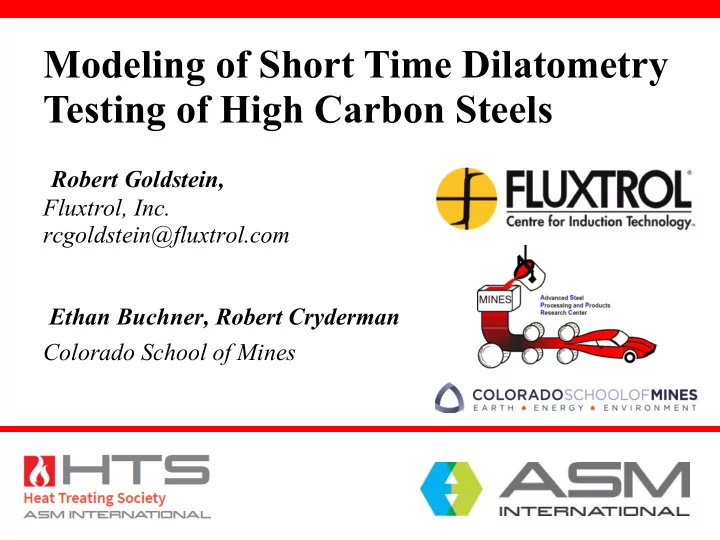

Modeling of Short Time Dilatometry Testing of High Carbon Steels Robert Goldstein, Fluxtrol, Inc. rcgoldstein@fluxtrol.com Ethan Buchner, Robert Cryderman Colorado School of Mines , Golden, Colorado
Overview • Effect of Short Time Heat Treatment on Transforma6on Phenomena • Test Results That Led to the Study • Dilatometer Descrip6on • Modeling Dilatometer Performance • Comparison Between Simula6on and Experiments • Conclusions/Future Research
Effect of Short Time Heat Treatment on Transformation Temperature Superior Performance of Components Has Been Achieved in Many Cases Using Non- Equilibrium Thermal Processes (NETP), but There Is Very Little Quantitative Data Available on Material Response to Rapid Thermal Processing
Recent Findings at ASPPRC of Improved Mechanical Properties with NETP Up to 3X better properties demonstrated using appropriate alloying elements and relatively short, low temperature heat treatment
Dilatometer Testing of the Steel for Materials Characterization Effect of Reduced Pre- Transformation Expansion with Increasing Cooling Rate called Temperature Gradient Effect and Led to Impression There Was Non-Uniform Temperature in the Sample Cooling Rates: � He: 235 ˚C/s � N: 91 ˚C/s � Ar: 52 ˚C/s
Dilatometer Description • Measures dimensional movement during thermal procession • Heating is in a vacuum • Heat source is induction heating • Advertised heating rate up to 1000 C/s • Gas quenching through induction coil used for cooling • Fused silica rods hold the component • Manufacturer TA Instruments
Modeling of Dilatometer Tests ● Heating and Cooling ● For Flux – ½ of simulations separated due to axisymmetric differences in enthalpy of system used phase transformations ● 1 D Program ELTA used initially to determine radial gradients and inverse calculations of material properties ● 2D Program Flux Used for Determining Full Temperature Distributions
Comparison of ELTA with Experimental Data ● Surface Temperature tracks closely ● Dynamics of power change very similar ● Big discrepancy in power level, measured substantially higher than calculated
Radial Temperature Gradients for Different Heating Rates with Helium Quench Radial Temperature Differential 100 90 80 Delta T 50 Cps 850 C 10 s 70 60 Delta T 100 Cps 850 C 10s 50 Delta T 250 Cps 850 C 10 s 40 Temperature (C) 30 Delta T 500 Cps 850 C 10s 20 10 0 0 5 10 15 20 25 30 35 40 -10 -20 -30 -40 -50 -60 -70 -80 -90 -100 Time (s) For 50 CPS, radial gradients much larger during cooling than heating. As heating rate increases, gradients during initial heating approach those from the rapid cooling. After Curie Point, radial temperature difference close to 0 for all samples during heating and holding phase
2D Modeling with Flux ● Axial Gradients are Larger than Radial Gradients on Heating According to Models ● Axial Gradients Also Exist on Cooling, with ends being colder than center for uniform heat transfer coefficient on surface
3 TC Testing and Comparison to Models Heating Experiments Models
3 TC Testing Cooling Comparison Experimental Cool End to Experimental End to End Models Excellent Agreement Initial Inversion of Cool End During Heating Gradient Compared to Models Hot End Axial Variation in Temperature is High, End to End Cooling Different, Initial Inversion Relative to Models Means We Have Significant HTC Variation in Length and Time!
Image During Cooling Hot End Cool End
Conclusions ● Models have been created to determine temperature distributions which occur during dilatometer testing ● Once the steel started transforming from magnetic to non- magnetic, the generator power level rises dramatically, limiting the ability to deliver high heating rates Need to understand better as there is a significant variance from ◗ calculated power levels and need to determine how to increase power delivery ● For rapid heating and cooling rates, there are significant gradients (both axial and radial) in the part which need to be considered when evaluating dimensional movement data ● More work still needs to be done to better characterize/ improve the cooling dynamics in the system
Recommend
More recommend